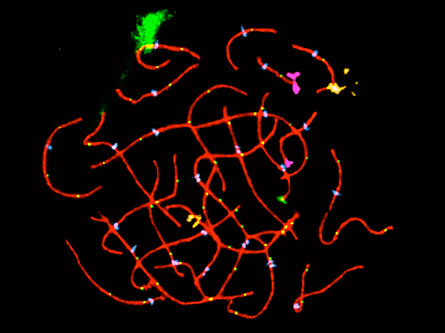- More than 2 years ago
PHILADELPHIA — Women and men sometimes do things differently, right down to divvying up their genetic legacies.

This divvying up is known as meiosis, a process that cuts the number of chromosomes in half during the production of eggs and sperm. Men do meiosis by the textbook, but women play it looser with the process, scientists from Washington State University and the University of Washington reported Nov. 12 in Philadelphia at the annual meeting of the American Society of Human Genetics.
The finding could help explain why women sometimes pass along the wrong number of chromosomes to their children, the researchers suggest. “The male doesn’t contribute to chromosome abnormality in any way,” says Terry Hassold, a geneticist at Washington State University in Pullman who presented the findings.
Some genetic disorders, such as Down syndrome, are caused by having an extra copy of a chromosome. Humans normally have two copies of each chromosome, one inherited from mom and one from dad. About one in every 700 babies born has an extra copy of chromosome 21, a surplus that causes Down syndrome. About one in every 1,000 babies born may have an extra X or Y chromosome, and one in every 1,000 girls may have only one X chromosome. Abnormalities in the number of other chromosomes often lead to miscarriage or to death soon after birth.
Humans are the only species known to have a high rate of error in the number of chromosomes they pass along, Hassold says. About 25 percent of all fertilized human eggs have the wrong number of chromosomes, he says.
“It’s a major problem and it’s only getting worse” as more older women have children, he adds. Such genetic mistakes happen more often after about age 35.
Hassold and colleague Edith Cheng from the University of Washington in Seattle decided to examine human meiosis to find a possible source for the high rate of error.
Fluorescent antibodies that latch on to proteins involved in meiosis allowed the researchers to see how the process happens. Hassold and his colleagues had already examined the earliest phase of meiosis in men and found that it follows the steps laid out in every biology textbook: a chromosome finds its match and the two pair up, gluing themselves together. Then the chromosomes swap some genetic information, a process known either as recombination or crossing over. Next, the chromosomes go through two rounds of division to form four sperm, each with one copy of each chromosome.
Previously, scientists did not have the tools to study human meiosis the way Hassold and Cheng have, says Stephen Warren, a human geneticist at Emory University in Atlanta. The new results provide insight about why humans tend to have higher rates of chromosomal mistakes, but the data fail to account for a large number of recombination events that scientists know must happen, he says.
Women may use more than one system for recombination, only one of which is visible using the technique in the new study, Warren speculates.
That suspended animation was known, but Hassold and Cheng found that, in addition, women’s chromosomes don’t behave the way men’s do.
In men, chromosome pairs zip themselves tightly together all along their length. But in women, Hassold saw “split ends” and “bubbles” where the chromosomes were not tightly joined. And women’s chromosomes had fewer recombination points than expected. About 5 percent of the chromosome 21 pairs the researchers examined had no evidence of recombination.
Recombination is necessary for proper chromosome segregation so failure to cross over could account for some of the errors in women, including passing along the wrong number of chromosomes.
The error-prone recombination process in women may have some evolutionary advantage, the researchers say, but they don’t know yet what that might be.
Warren suggests that one advantage of high rates of chromosomal mistakes is to help keep human family sizes small. Smaller families could allow parents to focus more attention and resources on offspring, increasing survival.






